The Following Article was written as part of the millenium celebrations for
the rural parish of Llansannor, near Cowbridge, in the Vale of Glamorgan
Stephen Bauzan
As Llansannor celebrates the new millennium we should spare a thought for the
longest surviving inhabitant of the parish. For many hundreds of years, the
effigy of a mediaeval knight has lain at the side of the altar of the parish
church. The tradition of the village has been that this is the likeness of
Stephan Bauzan, lord of Breigan and Llansannor in the Thirteenth century. If
the effigy is that of Bauzan then it can be said to be the father of the
parish, as both the Gwyn family of Llansannor Court, and the Thomas family,
which held the manor of Breigan until the Seventeenth century claimed to be
descended from the medieval Knight1
This identification has been disputed in more recent years, apparently partly
on the basis of the anachronistic dress of the figure2 , which is
depicted partly in Plate and partly in Chain-Mail armour. This was a style of
dress that belonged to the Transition period of military evolution, a somewhat
later era than that of Bauzan. The Effigy itself has received damage at some
stage and one leg has been repaired, however the legs are clearly crossed,
which is reputed to denote that the subject had been on crusade at some point
during his life.
The feet of the effigy rest on a lion, and there also appears to be a lion or
leopard crest on the helm
|
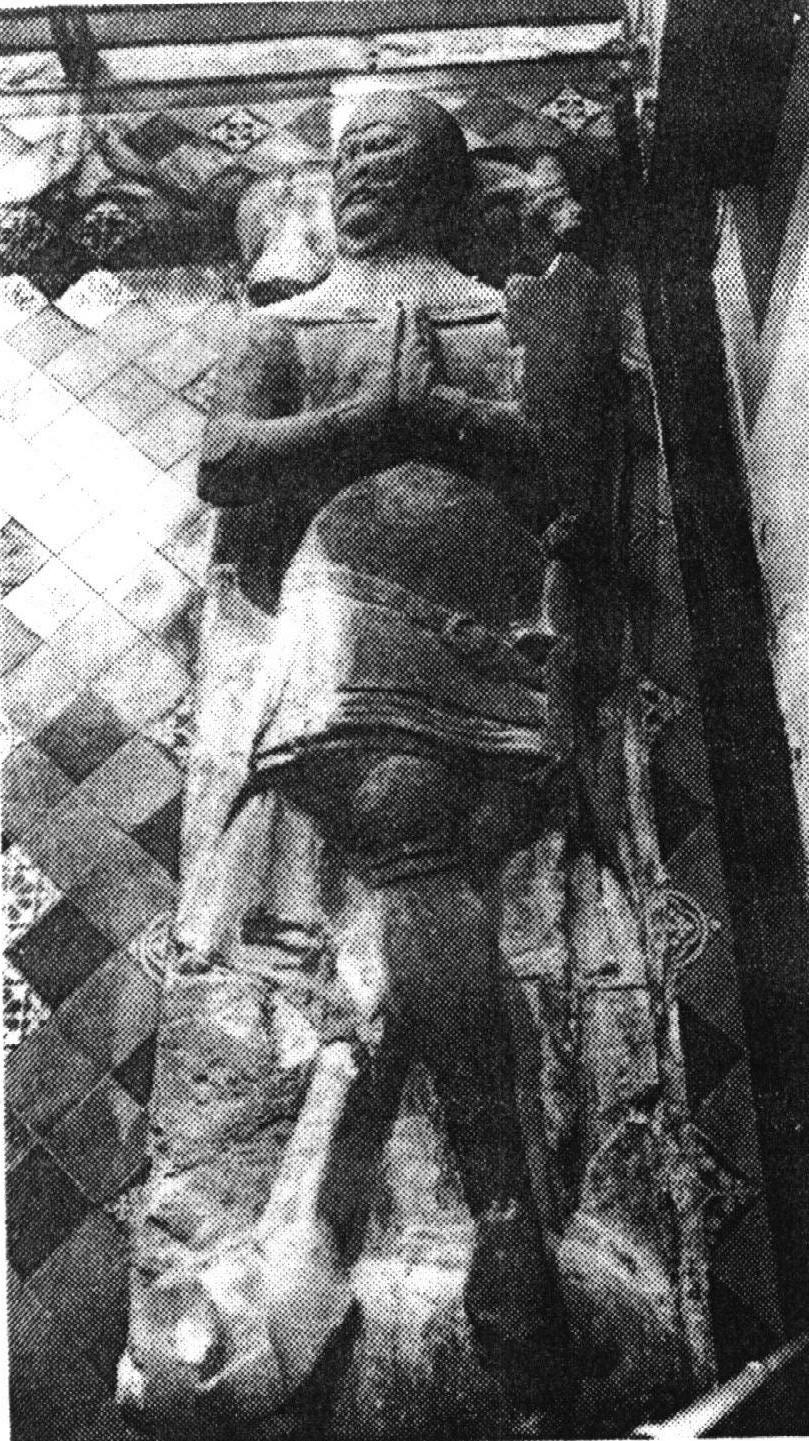
The Effigy in Llansannor Church
|
|

Tomb of Gilbert de Clare (Strongbow) in Dublin Cathedral
| Other examples of
cross-legged effigies were those of Strongbow, in Christ Church, Dublin,3(see photograph, left) and Reginald de Breos,
in the Priory of St Johns, Brecon.(now Brecon Cathedral)
- 'Crosslegg'd by him, as was the ancient trade
- De Breos lyes in picture as I trove '4
De Breos' charter to the monks of Brecon was granted after his return from the Holy Land,
which accounts for the 'ancient trade' of pulling the legs over on the monument.5
|
Before considering whether the figure represents Stephen Bauzan, we should first discuss the limited
information available about the thirteenth century lord of Breigan. The Stephen Bauzan who came
into the manor of Breigan shortly before his death in 1257 6has been identified as Stephen de
Bayeaux, a knight from Bayeaux in Lincolnshire7. He first seems to have come to South Wales in the
service of Gilbert Marshall Earl of Pembroke (1234-1241), for 'Stephen Bauzan, Steward of
Pembroke ' was a witness to an undated charter of the Borough of Haverfordwest8 .
Gilbert Marshall was the third of five sons of the first Earl of Pembroke, William the
Marshall, and had originally been trained for the church, however he seems to have been as much a
soldier as any of his brothers. After the death of his older brothers William and Richard, he had
succeeded in his turn as the Fourth Earl on 16 April 12349. The two younger brothers, Walter and
Anselm also signed the charter as witnesses, as did Walter Crasso the Elder, Steward of Tenby
Castle 123210 , and William, Prior of the Dominican Community at Christchurch, Brecon11.
Gilbert's nephew, Richard de Clare had become Lord of Glamorgan and Earl of Gloucester at the
age of 7, following the death of his father in Brittany. Originally, the Justiciar of England,
Hubert de Burgh, Earl of Kent, had been appointed his guardian however de Burgh fell from Royal
favour in 1232 and in 1236 Gilbert paid King Henry III the sum of 500 marks for the privilege of
administering the De Clare estates.12
In the mediaeval period, it was deemed a great favour for the monarch to appoint one of his
nobles as guardian of a royal ward (minor). The restrictions on a modern trustee did not then
exist and the guardian could easily apply the minor's assets pretty much as he pleased. Gilbert
himself seems to have entrusted the day to day administration of Glamorgan to Richard Siward,
Lord of Talyfan and Llanbleddian, for in 1234 Siward was described as the keeper of Glamorgan13 .
As the holder of Talyfan and Llanbleddian, Siward was also the feudal lord of Llansannor and
Breigan.
On 15 January 1239, Richard de Clare's mother Isabel, died, and after her burial, her second
husband, Richard, Earl of Cornwall, and her brother, Gilbert Marshall took the cross and vowed to
go to Palestine. Isabel's son, Richard naturally was keen to go and amongst the contingent of
English crusaders to Palestine that now assembled must have been included many of the Marshall
and de Clare Retainers14. Each of the party would have taken steps to put his 'affairs in order'
before leaving, for the journey to Palestine was long and perilous. Richard arranged to have his
guardian, Gilbert Marshall, repaid the 500 marks that he had deposited with the King on assuming
control of his nephew�s affairs 15. Gilbert himself, as Marshall of England, was a servant of the
crown and would have needed the Royal consent before leaving the Kingdom16 .
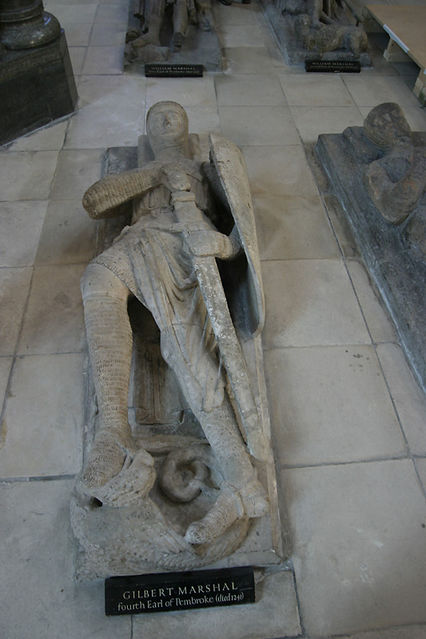
|
King Henry III was not keen for large numbers of his nobles to leave the country or risk
themselves unnecessarily, but least of all did he wish to loose the senior soldier of the realm.
When Gilbert asked for permission to leave for Palestine, Henry refused for a while, on the
grounds that the Marches of Wales were still unsettled following the death of the Prince of
Snowdonia, Llewelyn the Great. Richard of Cornwall therefore went on ahead to Palestine with his
young stepson; Gilbert stayed behind for a while to put the military position in order, intending
to join them in the Holy Land. Unfortunately, before leaving England, Gilbert held a farewell
Tournament at Hertford. Towards the end of the day, the bridle-bit of his unbroken war-horse
broke, and Gilbert was thrown from the saddle and then dragged some distance by the stirrup. By
the next day, 28 June 1241, he was dead of his injuries and the Earldom passed to his brother
Walter17.
|
|
An effigy was erected for the fallen crusader in the Temple Church, where it is amoung those described by Stow's "Survey of London", 1598,
"In the round walk (which is the west part without the quire) there remain monuments of noblemen there buried, to the number of eleven. Eight of them are images of armed knights; five lying cross-legged, as men vowed to the Holy Land against the infidels and unbelieving Jews, the other three straight-legged. The rest are coped stones, all of gray marble."
|
On 11 October 1240, the Earl of Cornwall reached the Crusader city of Acre18 , where he
conducted successful negotiations for peaceful Christian access to Jerusalem, and less
successfully intrigued for his Brother in law, Simon de Montfort, to be governor of the remaining
territories held by the Franks. According to Mathew of Westminster19 , amongst Cornwall's Entourage
was the young de Clare, who was, no doubt in turn escorted by some of his own retainers. It seems
quite possible that also in the party was Stephen Bauzan, either fulfilling his original
commitment to Gilbert Marshall, or perhaps already as a follower of Richard de Clare. We know
that Richard Siward had taken the vow to join a crusade 20, however he seems to have remained in
Glamorgan. The Earl of Cornwall left Palestine in May 1241, and presumably this was the date that
De Clare and his companions also returned21 .
As Richard de Clare reached adulthood he was clearly keen to take steps to wrest control of
his inheritance from his guardians. As we have already seen, before joining the Crusade in 1240,
he paid Gilbert Marshall 500 marks to obtain seisin of the lordship of Glamorgan at the age of
18. This was, however, probably an attempt to settle de Clare's affairs before his departure to
Palestine, as Gilbert was still asserting his rights as guardian right up to his death, in a
dispute with the king over lands held by the see of Llandaff22 . Meanwhile, Richard Siward still
held the post of keeper of the Lordship, and de Clare would need to arrange his removal
separately.
On August 1243 Richard de Clare attained the age of 21. At Michaelmas, he was Granted Full
Livery and Seisin and thereby assumed his inheritance as the feudal lord of Glamorgan, and the
Earl of Clare, Hertford and Gloucester. He was now one of the most powerful magnates in England
to, to whom almost 1/3 of the Feudal host of the Kingdom owed allegiance23 . Not long after
entering into his inheritance, he appointed Stephen Bauzan as Sheriff of the County24 . This was a
partly military, partly judicial post and probably formed part of a deliberate campaign to reduce
the influence of Siward in Glamorgan.
As feudal lord of Glamorgan, de Clare was the ultimate judicial authority in the County and
thus he quickly had Richard Siward summoned to appear before a jury of 12 of his equals at a 'day
of the march' to be held on Stalling Down25 . Siward was charged with treason against the earl, by
having broken a truce between de Clare and Hywel ap Meredydd, the Welsh lord of Miskin and
Glynrhondda. He was also accused, somewhat paradoxically, of having colluded with Hywel ap
Meredydd in evading Norman patrols.
The scene is quite graphically described in the documents assembled for Richard Siward's
appeal; 12 jurors; 6 Norman Knights, representing the Earl, and for Siward, 6 Welshmen,
presumably of equivalent status, assembled at the rendezvous. Then Stephen Bauzan, probably
acting as sheriff of the County, demanded judgement on behalf of the earl and offered his body
against that of Siward, in other words offering to settle the case by Trial by Combat. Siward's
attorney appealed to the Judgement of the Court whether he was obliged to answer Bauzan on the
grounds that Bauzan did not belong to the county, nor was he Siward's Peer. To this the Earl
answered that Bauzan was his liegemen and a member of his household26 and hence of appropriate
status to meet in Combat with a Lord of the March.
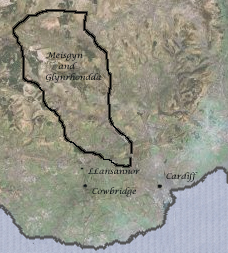 | Siward was not prepared to fight with Bauzan, and the challenge went unanswered, despite the
manors of Talyfan and of Llanbleddian being pledged as Surety and Bauzan's challenge being
repeated at two further sessions of the 'comitatus ' later in the year. At the fourth session of
the Court of the March, De Clare used his position as Lord of the honour of Glamorgan to declare
Siward in default of the summons to attend the court. He therefore declared him an outlaw, and
'Wayviatum' or Wolveshead 27, and confiscating the whole of the territory owned by Siward. Hywel ap
Meredydd had fled to the court of Llewelyn ap Gruffydd, so De Clare also seems to have taken the
opportunity to seize Hywel's commotes of Miskin and Glynrhondda, presumably in retaliation for
the open rebellion displayed after the ending of the truce. |
This quasi-legal land-grab brought under the direct control of the Clare the whole of the
territory from the Manor of Llanbleddian to the northern end of the Rhondda valleys. De Clare
redistributing this land to suit his own ends. Charters were issued for the new town of
Llantrisant and in this period the first permanent buildings to be found in Cowbridge for over 8
centuries were established. Holy Cross Church began to be rebuilt in stone and the new dedication
befitted the zeal of a recently returned crusader28 . De Clare granted to Bauzan the manor of
Breigan with Llansannor, and Scurlage, another of de Clare's retainers was established at
Trecastle, Llanharry.
Siward appealed to king Henry III, but at this period even the King of England himself had
little influence over the legal process in the Lordship of Glamorgan, where the Marcher Lord was
almost a sovereign in his own right29 . At the beginning of 1248, Mathew Paris records that Richard
Siward had taken to his deathbed, and the margin of the chronicle is illustrated with an inverted
shield bearing Siward's Coat of Arms, a sign that he soon after died30 . Sometime in the 1250s,
Bauzan received formal title of the land that he had probably occupied soon after the
confiscation31 .
In any case the undisputed formal declaration of the confiscation of the Estate, had been
contrived in the presence of a constituted Jury, and of the Earl of Glamorgan, being both on the
manor of Llanbleddian and in sight of that of Talyfan. This would under feudal law probably have
itself been enough to grant to Bauzan, on behalf of de Clare, formal seisin of the manors33 .
Notably, Welsh Law also required that transfers of land be made on or in sight of the land itself33
. After completing at least two terms of office as the sheriff of Glamorgan , Bauzan transferred
his allegiance to the Henry III 's son and heir to the throne, Lord Edward, who would later
become King Edward the First. In 1251, he is referred to as a follower of the Queen, Edward's
mother35 , and, two years later, he is mentioned in her 'jewel' roll as one of the Lord Edward's
knights36 .
Clearly, this position brought him further into the royal favour for from 28 April to 23
October 1255, Bauzan served as Seneschal of Gascony, an important position in an age when Gascony
was a substantial and turbulent province of the Angevin Possessions.
After a decade of internecine strife, the leadership of the Welsh Princes had passed to
Llewelyn ap Gruffydd, grandson of Llewelyn the Great. Meanwhile, Edward Longshanks was himself
coming of age. To induct him into the art of government, Edward was created Earl of Chester, and
thereby became a Lord of the March in his own right. Edward quickly began to increase the
pressure on the Welsh princes on his border. Llewelyn was quick to retaliate by backing Meredydd
ap Rhys against his nephew, Rhys Fychan.
In September 1256, Stephen Bauzan was sent to command a substantial force operating in the
area of Carmarthen, made up partly of the forces raised by the local marcher Lords, and the
remainder consisting of troops raised directly by the king, including a contingent from Gwent37 .
The English troops however were, limited to forays into the area close to the borough as they
were at this period severely hampered by the restrictions imposed by Magna Carta on the
employment of Mercenary troops, and were restricted to employment for 40 days38 . Bauzan, and the
Steward of Carmarthen, Patrick de Chaworth instituted for the first time a 'comitatus' or County
Court at Carmarthen, seeking to impose English Law on the Area around the town. On 4 Feb 1257,
Bauzan and his troops gained notoriety by a raid on Whitland Abbey, during the course of which at
one of the abbey servants was killed, and valuables removed from the abbey39.
At this point, political intrigue in the Welsh camp provoked a crisis. In the vicinity of
Carmarthen, the local dynasty was riven by a continuing dynastic dispute between the
Grandchildren of Lord Rhys; Meredydd ap Rhys Gryg, who held Dryslwyn Castle, and his Brother,
Rhys Mechyll, who had married into the de Breos family and held Dynefor and Carreg Cennan. On
Rhys Mechyll's death the castles would have fallen to his son Rhys Fychan, had not Rhys Mechyll's
Widow 'treacherously delivered it into the power of the French'40
Rhys Fychan now came to the comitatus with a proposal. He would join his retainers to their
forces, and guide them to his castle of Dinefwr, further up the Towy valley than Dryslwyn. This
would give the English a secure base from which to isolate Meredydd ap Rhys from his ally,
Llewelyn ap Gruffydd. Just before Whitsun, 1257, Stephen Bauzan and Nicholas de Martin, Lord of
Cemmais led a strong force of over 2000 horse and foot to Dinefwr.
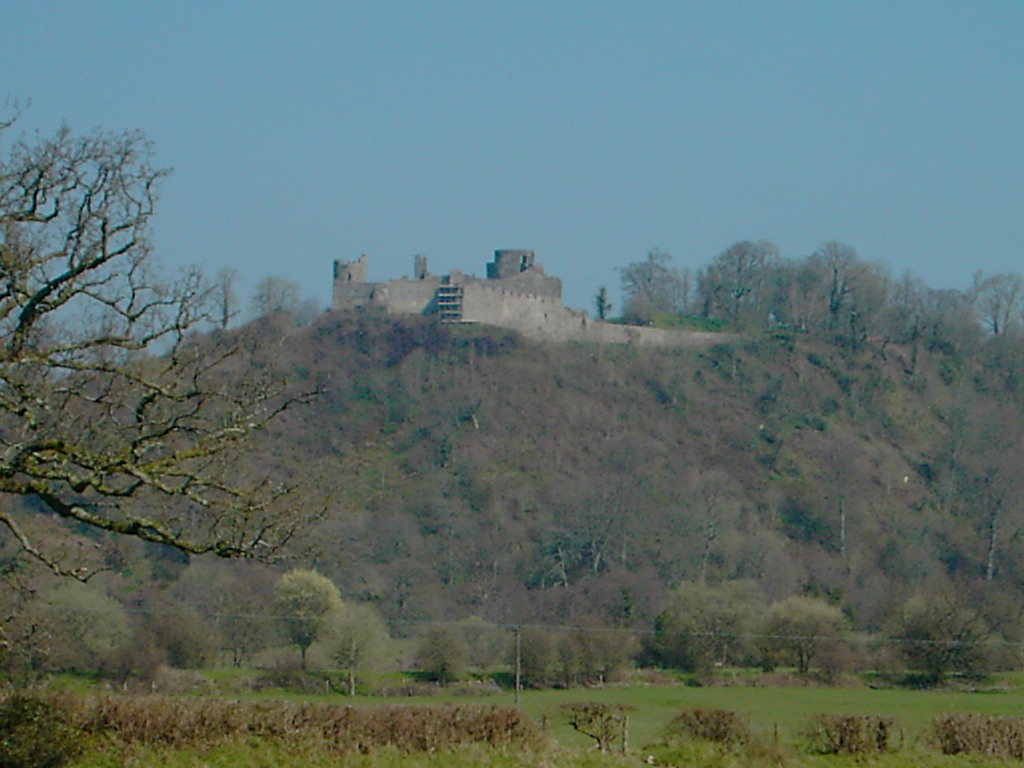 |
Eight Hundred years ago, the land use in the Towy valley was quite different from now, but
fortunately, we have a description of the area only a generation earlier, in Gerald the
Welshman's Description of Wales. He describes Dinefwr, which was then the historical seat of the
princes of Southwest Wales, as 'a safe refuge for the inhabitants of south Wales because of the
impenetrable forests. There, too is Dinefwr Castle, built on top of a high hill which overlooks
the river Towy and which is held to be the Royal Seat of the Princes of Wales'. This terrain
would not have suited the heavily mailed English knights and they would have had to rely on Rhys
Fychan and their other Welsh allies for guidance and screening on whatever route was used to lead
them to Dinefwr. |
Once the force was drawn up near to the Castle, Rhys Fychan went on to the Castle with a small
force. English and Welsh sources disagree on what happened next. The chronicler of 'Brut y
Tywysogion, writing in Welsh, sets the scene thus;
'and after that Rhys Fychan ap Rhys Mechyll gathered a host past telling of barons
and Knights from England; for it was in England that he was then, And he set out from Carmarthen
in Whitsun Week. And thence they came to the castle of Dinefwr. And after he had come to the
Castle, the garrison seized him.'
Other versions of the same tale suggest that Rhys changed sides when he reached the safety of
the castle, in which case one might well speculate on his motives in luring such a large English
Force into an exposed position. It is perhaps relevant, that although Rhys' mother may have been
a de Breos, his wife was the sister of Llewelyn ap Gruffydd himself. In any event, the English,
deprived of their Guides, were now cut off form their base at Carmarthen.
| Thirteenth century knights would have ridden to the battlefield on a Palfrey and then changed
mount to their Destriers (war-horses) before approaching the enemy positions. This was partly to
keep the expensive Destrier in good condition, and partly, as has already been seen from the
unfortunate end of Gilbert Marshall, due to the possible consequences of riding a mount selected
mainly for its size and aggression. It seems that the palfreys and other equipment had been left
near the present-day village of Broad Oak, on the A40 Carmarthen Llandeilo Road, (then the remains of the old ROman Road, The Via Julia) where they would
have been out of line of sight from Meredydd ap Rhys' stronghold of Dryslwyn Castle. Before the
Knights could regain their normal mounts, it appears that the Welsh had attacked the English
Baggage and driven them off, together with the reserves of ammunition. | 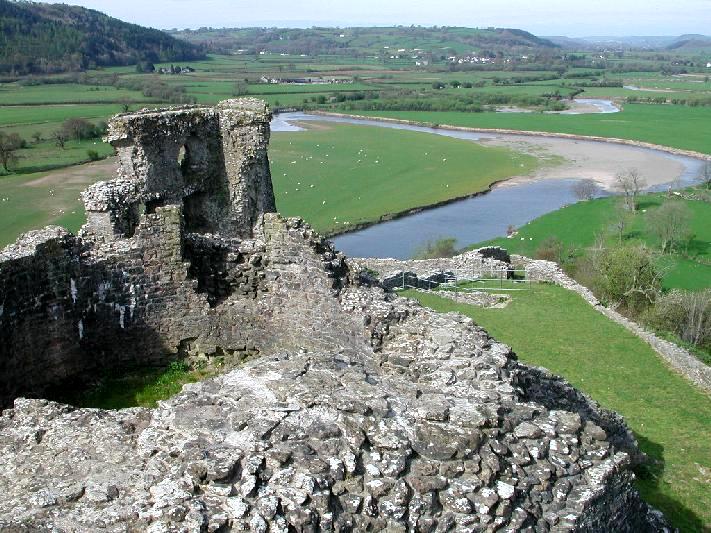 |
| View from Dryslwyn Castle. The Old Roman Road lies to the right of the river Towy, just out of the picture |
Now the English found themselves under steady attack from the Welsh concealed in the Woods,
who 'assailed them with javelins and arrows'. In a situation where there could be no reliance on
their Welsh Auxiliaries, their options would be few. It is most likely from the known tactics of
Norman Knights in similar, better recorded, encounters, that they attempted to charge through
their opposition, and to make their escape to Carmarthen41 by using the weight and momentum of
their mail-clad war-horses to simply ride down their opponents.
 View from Broad Oak along the A40(Via Julia) In the narrow valley the marshy course of Nant Steffan would have impeded the Norman horse and given the Welshmen an ideal Ambush point |
Unfortunately although the heavier build and armour of the Norman horses will have allowed
them to escape, the Destriers will have tired more quickly than the lighter Welsh mounts.
Somewhere near Pontargothi, where the River Cothi runs into the Towy, the Normans lost momentum
in the marshy approach to the river, and there their pursuers overran them. Overall at least 1000
and possibly as many of 3000 of the English were slain, Stephen Bauzan amongst them. |
After a medieval battle, most bodies were left unidentified. The chroniclers specifically tell
us that 'the Welsh, greatly victorious, with the mail-clad horses and arms of their enemies as
their spoil, gave thanks to God and returned in safety to their Homes42. [It perhaps no coincidence
that it was in next year that Llewellyn's army for the first time was reported to include a body
of 80-240 men mounted on barded (armoured) horses43 . This store of arms and armour must have been
stripped off the bodies of the fallen knights and their retainers. Most likely the remainder of
the clothing would also have been looted leaving a large number of mutilated, naked bodies.] Even
disregarding Gerard the Welshman's statement that the Welsh were in the habit of beheading the
bodies of their fallen enemies44 , it is most unlikely that the body of Stephen Bauzan was ever
identified.
Many years passed before any monument was erected to the fallen knight, for in the aftermath
of the battle both King and marcher Lords were preoccupied with other matters. In 1258, led by De
Clare and his old crusading comrade, Simon de Montfort, the English Barons confronted the king
and forced him to agree the Provisions of Oxford. This confrontation would be celebrated by the
Whig historians, as being the original precedent for regular Parliaments. The main concern of the
Baronage though, was to force the King and Prince Edward into a truce with the Welsh45 . Henry III
therefore agreed to recognise Llewelyn ap Gruffydd as the Prince of Wales. This was a title that
had not been aspired to even by his grandfather, Llewelyn the Great. Then England was plunged
into a long struggle between de Montfort and the King with Llewelyn and the Marcher lords
together holding the balance of power.
After the death of Richard de Clare (1262) his son Gilbert finally committed the resources of
the Lordship behind the King, perhaps in reaction to a growing threat from Llewelyn. After Simon
de Montfort was killed at the battle of Evesham, a fresh war with Gwynedd resulted in Llewelyn
being dictated much inferior terms.
|
In 1272, Edward I came to the throne and set about provoking Llewelyn to a final show down.
Although in 1282 Llewelyn was killed, in 1287 the Royal forces were still committed to a campaign
against Rhys ap Meredydd, the son of the victor of Coed Llathen, whose men made a stubborn last
stand at the castles of Dryslwyn and Newcastle Emlyn46 . Although now in his fifties, Edward
Longshanks had obviously not forgotten the Knight killed in his service in the same area, almost
thirty years before. The King authorised the payment of 105s for a monument to Stephen Bauzan and
a Richard Griffin, also apparently a casualty of the Welsh Wars47 , and the Constable of Bristol
records two stones taken to Carmarthen for these monuments48 .
| 
The Arms adopted by Edward - now the 3 Lions of England. Note that the effigy at Llansannor appears to have a lion as the crest of his helm, and his head rests on another |
Gilbert de Clare and the Marcher lords eventually raised an Army of over 10000 men and the
fighting swung their way. By 1290 Rhys was a captive of the king, and was taken to York for
execution. Also taken was his son, also called Meredydd ap Rhys, who was held in Carmarthen
Castle. Whether voluntarily or not, Meredydd formerly confirmed a grant of land made over 60
years earlier by William de Breos, who had been executed by Llewelyn the Great in 1230. The
property consisted of the advowson of a church at Ebernant, and its chapel at Cynwil Elfed, to
the Priory of St John's Carmarthen49 . Attached to this confirmation was the condition that the
Canons of the Priory should say mass for the soul of Stephen Bauzan and Richard Giffard 'and all
the other men fallen in the king's service'50 . It seems reasonable to assume therefore, that the
effigy was placed, not in Llansannor Church but in the Priory of Carmarthen.
This is the second reason why several writers have ruled out the possibility that the
Llansannor effigy represents Stephen Bauzan. To our mind this is a more concrete objection than
that of the style of dress of the effigy. You will note that the Carmarthen effigy was not
ordered until 1287, 30 years after the knight died. In St David's cathedral is a similar effigy
of the Lord Rhys, Prince of West Wales, who died in 1197, fifty years or so before Bauzan, yet
the date and style of the two effigies is quite similar. Sculptors and artists of the medieval
period were not as conscious as we of the need to depict the correct costume on historical
figures. This can be seen in many famous paintings of the period depicting biblical figures in
medieval dress, or knights in full plate armour and caparisoned horses representing Caesar and
Pompey, or the battle of Hastings.
It seems a pity though to eliminate Stephen Bauzan as our suspect for the effigy in the parish
Church. As a leigeman of Gilbert Marshall or Richard de Clare, he does seem quite likely to have
gone to the Holy Land with Richard in 1240. Few of his descendants are likely to have been
crusaders, for only 35 years after Bauzan's death, the last remnants of the Crusader kingdoms of
Outremer had been overrun, and the Crusades soon fizzled out. The only other known contact of the
Parish with the Crusades, ironically enough, was Richard Siward, who had apparently vowed to take
the cross some years before his removal in favour of Bauzan. The effigy was certainly made some
time after the life of Siward and Bauzan and it seems unlikely, given that Siward was effectively
outlawed for treason to the Lord of Glamorgan, that any of his successors would have wished to
honour him in that way, so many years after.
| The effigy erected in Carmarthen of course is no longer there, for at the Reformation, the
Priory, along with all other religious foundations with an income of less than 200 pounds per
annum, was abolished51 . An inventory of the goods of each of the Monastic Houses was prepared, but
unfortunately, whilst there is a considerable amount of information regarding the state of the
Priory's affairs, there is not mention of a monument. It is of interest however that the other
Monastic Establishment in Carmarthen, the Friary, is noted as holding 'a fine effigy of Sir Rhys
ap Thomas' 52. This is relevant to our case because the effigy in question was not left for random
looting and vandalism in the ruins of the Friary, but was carefully moved from its original
location and repositioned in St Peters Church, at the other end of town. In fact many of the
artefacts and decorations of the pre Reformation Churches, down to the lead from their roofs and
the very stones themselves were sold by the new owners. |
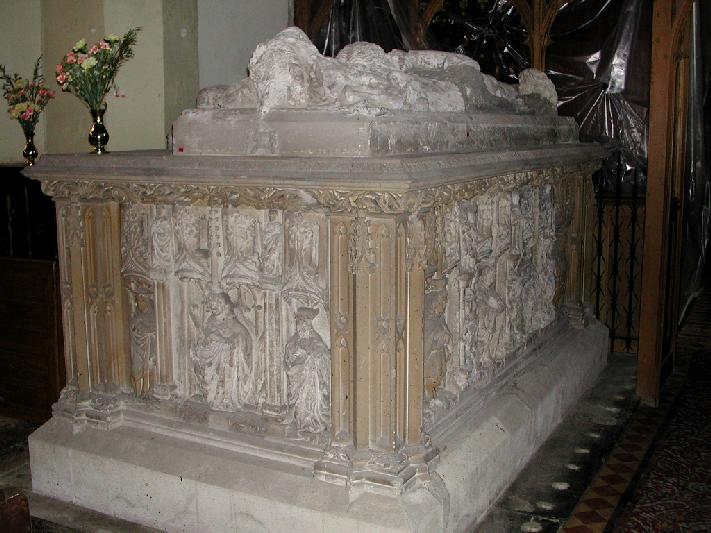 |
Effigy of Rhys ap Thomas now in St Peters Church, Carmarthen |
|
Could the effigy, paid for in 1287 by Edward Longshanks have been moved to Llansannor? For on
July 20 1542,much of the land belonging to the Priory, including the Priory itself was leased to
a Richard Gwyn53 .
|
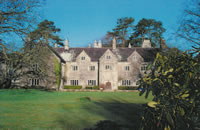
|
The first representative of the Gwyn Family recorded at Llansannor Court was
Richard Gwyn of Lincoln's Inn 1556-8, who is recorded as acquiring a Capital messuage (Manor
House) and two dwelling houses at Llansannor54 .
|
|
|
Llansannor Court Today | |
 |
The Gwyns claimed descent from Bauzan, and Richard Gwyn, setting his household up as that of a Tudor gentleman, had a good motive to substantiate his lineage by moving the Statue back to the manor church. |
 |
| Llansannor Church | | Another view of Llansannor Church |
After all these centuries, who can say? We think it implausible that a second effigy should
have been made of a comparatively obscure figure. But, if the Llansannor Effigy is not the
monument originally placed in Carmarthen by order of Edward I, then who does it represent?
Sources
- Old and Extinct Families of Glamorgan
- .David Francis : The Border Vale
- Dictionary of National Biography p393, Richard de Clare (d.1176)
- Churchyarde 'Worthinesses of Wales' quoted in History of Breconshire.)
- History of Breconshire
- Archaeologica Cambrienses 1878 p12
- Carmarthen Antiquary - Vol. 5 p 2 'Stephen Bauzan' Geo Eyre Evans
- Transcription of the Charter of Haverfordwest - Pembrokeshire Record Office The original charter has been lost, but the full text was reiterated in the Charter granted by Edward IV to Haverfordwest, 12 March 1465.
- Archaeologica Cambrienses 1860 p86-91; The Earls, Earldom and Castle of Pembroke VI
- Calendar of Public records relating to Pembrokeshire p99 Document 1366
- The Dominicans also had a Priory at Haverfordwest
- Tewkesbury Annals p124-5 (cit. Glamorgan County History)
- Archaeologica Cambrensis XXXVI Oct 1878 'The appeal of Richard Siward.' GT. Clark
- Archaeologica Cambrienses 1860 p86-91; The Earls, Earldom and Castle of Pembroke VI
- Glamorgan County History
- Archaeologica Cambrienses 1860 p86-91; The Earls, Earldom and Castle of Pembroke VI
- Archaeologica Cambrienses 1860 Earls of Pembroke VI. ; After the death of Gilbert, the Earldom of Pembroke was held briefly by each of the youngest brothers, Walter and Anselm. On Anselm's death in 1246 the whole estate was divided between the 5 sisters and their heirs (Calendar of Public records relating to Pembrokeshire p99 Document 1366) (Archaeologica Cambrienses 1860 Earls of Pembroke VII)
- Sir Stephen Runciman; History of the Crusades p218
- Mathew of Westminster cit. Dictionary of National Biography ; Richard de Clare (1220-1262)
- Archaeologica Cambrensis XXXVI Oct 1878 'The appeal of Richard Siward.' GT. Clark
- Sir Stephen Runciman; History of the Crusades p 219
- Glamorgan County History
- Welsh Wars of Edward I; Lloyd
- Glamorgan County History
- During the nineteenth century, the surviving records of what followed were transcribed and translated by the Glamorgan genealogist and antiquarian, GT. Clark, and his analysis of the Curia Regis proceedings, published in 1878 have been a major source for what follows. There is however, a problem with the dating of events followed by GT. Clark. Clark states that in July 1245, Siward was prosecuted for breaking a truce which ran from 'the Sunday following the 11th of November to the 6 of January next following, 1246'. The text of this sentence in Latin is 'a die Dominica proxima post festim Sanct Martini durature usque as Epiphanium proximo sequentum ejusdem anni.' This certainly means that the truce would last until the feast of Epiphany next following - but which year? I follow the date given in Glanmor Williams' Article in the Glamorgan County history, based on the Annals of Tewkesbury Abbey, That is that the truce began in 1242, and should therefore have run until 6 January 1244. This is consistent with Stephen Bauzan's appointment as Sheriff in 1243 and continuance in Office until 1247, also with De Clare, and possibly Bauzan's absence in Palestine from Autumn 1240 to Mid 1241. After Siward's taking several Welshmen hostage broke the truce, Hywel ap Meredydd retaliated by seizing a Thomas de Hodnack. The sheriff who remonstrated with Hywel ap Meredydd was Bauzan's predecessor, William Wauton, which therefore dates he incident to December 1242.
- This is consistent with observation of the Glamorgan County History to the effect that the majority of the sheriffs of Glamorgan serving during the de Clare Earldom were Members of the De Clare household before taking office.
- Archaeologica Cambrensis XXXVI Oct 1878 'The appeal of Richard Siward.' GT. Clark
- Cowbridge Glamorgan Gwent Archaeological Trust
- Archaeologica Cambrensis XXXVI Oct 1878 'The appeal of Richard Siward.' GT. Clark
- Illustrated Chronicles of Mathew Paris+, Richard Vaughan
- In addition to the manor of Breigan, Bauzan also held 1 1/2 knights fees in the portion of William Marshal's estate divided between the heirs of Sybil Marshal, who married William De Ferrars, Earl of Essex (Calendar of Public records relating to Pembrokeshire p99 Document 1366, Archaeologica Cambrienses 1860 Earls of Pembroke VII). Also, after the death of his brother John de Bayeaux in 1249 he inherited the De Bayeaux estates, held in Capite (direct form the crown) in Lincolnshire and Somerset (Archaelogia Cambrensis 1878, Appeal etc). Finally, it appears that he left his widow, Agnes, his manor of Wooton, Oxfordshire (Archaelogia Cambrensis 1878, Appeal etc), although we have not been able to ascertain how he came by this property.
- Elements of Land law ; Kevin Gray p61
- Laws of Hywel Dda
- Glamorgan County history Bauzan served as Sheriff of Glamorgan until about 1246.
- Exchequer Records PRO [E101/349/12 M11 cit. Llewelyn ap Gruffydd, J Beverley Smith)
- Calendar of Chancery Rolls cit. Llewelyn ap Gruffydd, J Beverley Smith).
- (Muster Accounts for the Lordships of Abergavenny Grosmont and White Castle1256-57 SWMRS 3 (1954) 21-47 cit. Llewelyn ap Gruffydd J Beverley Smith).
- Lloyd; Welsh wars of Edward I).
- Annales Cambriae
- Brut y Tywysogion cit. Carreg Cennan (CADW).
- Annales Cambriae says Cardigan ,but this seems to be a mistake; See Discussion by J Beverley Smith in Llewelyn ap Gruffydd for an alternative interpretation.
- Annales Cambriae.
- Conquest Coexistence and Change: Wales 1063-1415 RR Davies p255).
- Description of Wales Book 11 Chapter 8
- Mathew Paris English Historical documents
- Welsh Wars of Edward I; Lloyd
- Carmarthen Antiquary - Vol. 5 p 2 'Stephen Bauzan' Geo Eyre Evans
- PRO, SC 6/851/1, Cit. Transactions of the Carmarthenshire Antiquarian Society & Field Club 1905-39
- Archaelogia Cambrensis
- Carmarthen Antiquary - Vol. 5 p 2 'Stephen Bauzan' Geo Eyre Evans
- Henry VIII Act to Abolish the Lesser Monasteries
- State papers cit. Francis Green Collection Vol. 12
- Augmentation papers cit. Francis Green Collection Vol. 12
- Calendar of Early Chancery Proceedings concerning Wales
This information placed on the web by A40infobahn. Our other related subjects include
- The Heritage Centre reenactment group,
- Biography of Sir Henry Vaughan of Derwydd,
- Reenacting the English Civil War with Sir Henry Vaughan's Company of the Sealed Knot Society
- If you have a local or family history project in the South Wales area, A40 infobahn may be able to provide Research Assistance
|
These Webpages have been promoted with the assistance of Google Adsense as a service to all of our clients.
|









